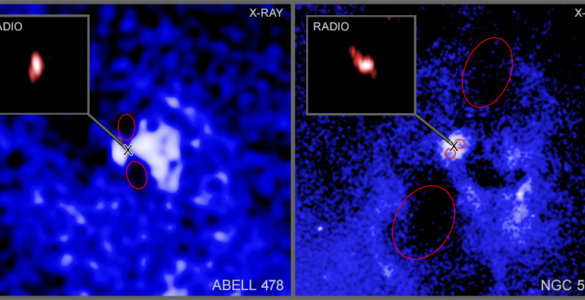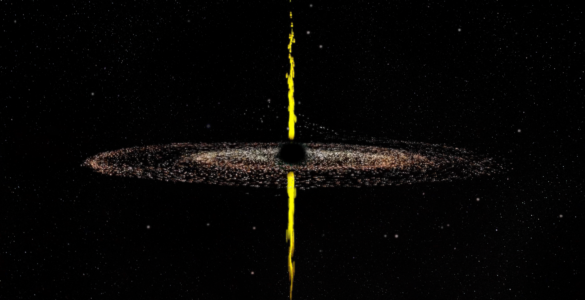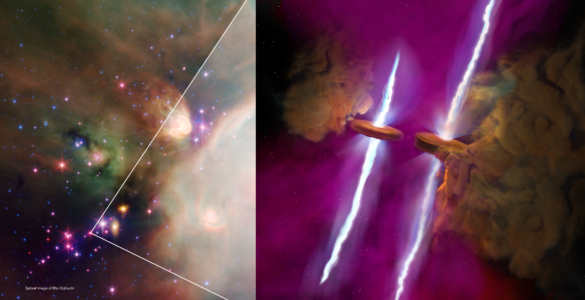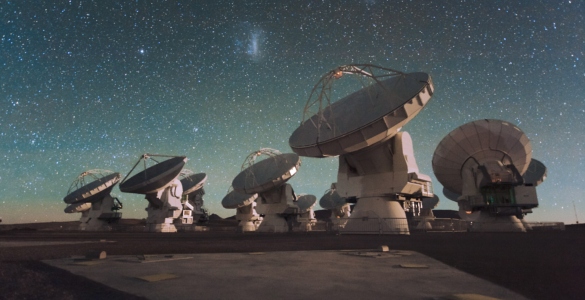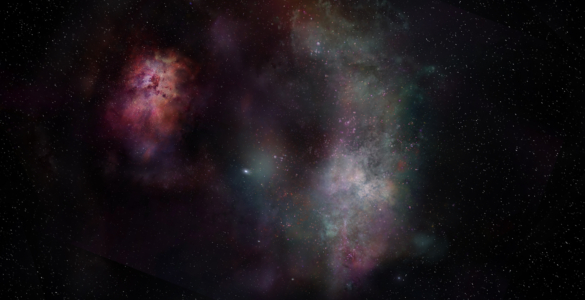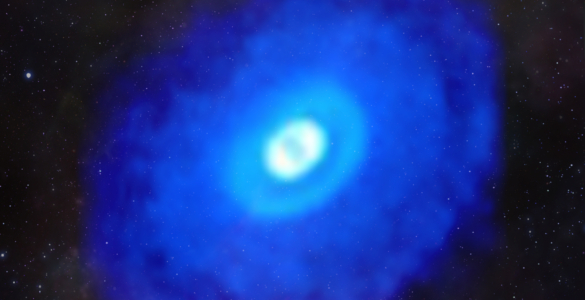New observations with the National Science Foundation’s Very Long Baseline Array (VLBA) radio telescope have deepened the mystery surrounding water molecules in a galaxy 65 million light- years away. The water molecules are acting as natural masers — amplifiers of microwave radio emissions — and these cosmic masers within the galaxy NGC 1052 are raising difficult questions for astronomers trying to explain them. Results of the new observations, which pinpoint the location of water masers in NGC 1052, were announced today at the American Astronomical Society meeting in Toronto, Ontario.
The researchers are: Jim Braatz of Harvard University in Cambridge, Massachusetts, Mark Claussen and Phil Diamond of the National Radio Astronomy Observatory in Socorro, New Mexico, Andrew Wilson of the University of Maryland in College Park, Maryland, and Christian Henkel of the Max Planck Institute fur Radioastronomie in Bonn, Germany.
Water masers have been detected in several other galaxies. However, most galaxies containing water “megamasers” such as those in NGC 1052 are spiral galaxies. NGC 1052 is one of only two elliptical galaxies in which water megamasers have been detected. Because ellipticals tend to have much less gas and dust than spirals, the existence of the water masers in NGC 1052 is surprising by itself, though that galaxy does have more gas and dust than the typical elliptical. Located in the constellation Cetus, NGC 1052 also has an active nucleus, believed to be powered by the gravitational energy of a supermassive black hole at its core.
The new VLBA observations produced an additional mystery. In other galaxies with water megamasers, the masers are believed to lie within a disk of molecules orbiting the galaxy’s central black hole. This is the case, for example, in the now-famous galaxy NGC 4258, where the movement of the orbiting disk can be traced by measuring both the Doppler shift of radio emission from the masers and by tracking the motion of individual maser “spots” as their orbital motion carries them across our line of sight. However, in NGC 1052, this does not appear to be the case.
Instead of residing within a disk orbiting the possible black hole, the water masers in NGC 1052 may lie in a “jet” of material being ejected by the central engine of the active nucleus. The high-resolution VLBA observations allowed the team of researchers to locate the water masers with respect to the jet. If the masers were in a disk around a black hole, the masers would be expected to lie in a line perpendicular to the jet axis around the radio core. Two “clumps” of maser emission, each composed of several weaker features, were found instead to lie along the jet axis.
“The fact that the masers don’t lie transverse to the jet axis means that these masers possibly do not trace a molecular disk around a possible black hole, but could be coming from gas either in the jet material itself, or in some molecular gas just in front of the jet,” said Claussen.
The researchers don’t yet know exactly which of the radio continuum brightness peaks represent the true core of the galaxy, but further analysis of existing data taken by other groups in conjunction with the new data will allow them to determine just where the central engine lies with respect to the jet and the water masers.
The shape of the spectrum of the water masers in NGC 1052 also is different than that of the other water megamasers. Typical spectra of water masers in spiral galaxies are composed of many narrow, “spiky” features. The maser spectrum in NGC 1052 is broad and relatively smooth. Periodic monitoring of the maser emission in NGC 1052 using single-dish radio telescopes in Germany, Australia, and the United States has been performed over the past two years. In that time, the features of the maser spectrum have drifted toward longer wavelengths, presumably because of velocity changes that affected the Doppler shift of the radio waves. The overall velocity has changed by about 50 kilometers per second during this time. Velocity drifts of the narrow water maser features in NGC 4258 have been ascribed to orbital motions of the gas in a nuclear molecular disk around the black hole. It is unclear whether the changing maser profile in NGC 1052 has a similar origin.
“The smooth shape of the spectrum, the location of the masers along the jet and the fact that NGC 1052 is an elliptical galaxy are all indications that the masers in NGC 1052 trace a different kind of interaction than the masers in NGC 4258,” said Diamond, who also works with the team of astronomers studying the masers in NGC 4258.
The team of astronomers used the VLBA, an instrument comprising 10 25-meter diameter antennas across the United States from the U.S. Virgin Islands to Hawaii, which provides the fine resolution necessary to pinpoint the position of the maser radio emission to an accuracy better than 1 milliarcsecond. The instrument is operated by the National Radio Astronomy Observatory from an operations center in Socorro, New Mexico.
The National Radio Astronomy Observatory is a facility of the National Science Foundation operated under cooperative agreement by Associated Universities, Inc.








